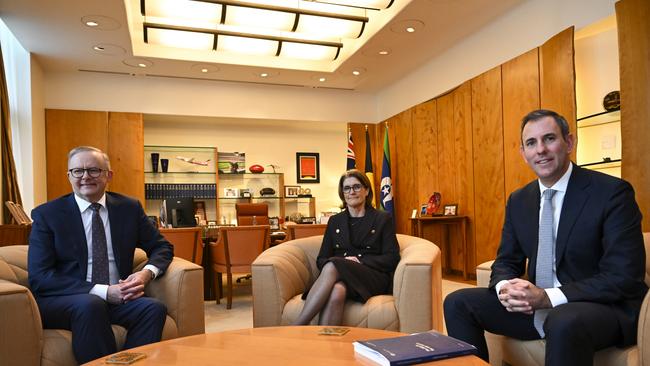But Bullock is vulnerable to both the actions of US politicians plus our local government, which is setting policies that will inevitably escalate costs of doing business in Australia
Accordingly, in Australia unless Bullock is very skilled in communication, she will be blamed for any larger than expected interest rate rises during 2024 or 2025 as a result of the actions of the politicians.
In the US, President Joe Biden is supporting the United Auto Workers union in their dispute with two of the big motor companies (Ford is exempt) and Republican frontrunner Donald Trump plans to visit Detroit in support of the workers.
At the same time, the Biden government is engaged in a massive spending program.
Federal Reserve chairman Jerome Powell must look with horror both at the US spending and the sight of the presidential incumbent and his major challenger both swinging to the union side, which means that higher wage rates will very likely spread around the US economy, boosting inflation which in turn will require higher interest rates. The bond markets are already forecasting higher overall rates.
The US two-year bond rate is now around 5.2 per cent and the 10-year bond rate is around 4.4 per cent – both close to their highest levels since the 2006-07 period. These rates along with an official cash rate of 5.3 per cent have helped slash US inflation, but the actions of Biden and Trump are warning signs of what may be ahead.
If the US is forced to lift rates further – and Powell is giving warning signals – then Australia will need to either match the US or our dollar will be endangered.
The current low Australian dollar in boosting the cost of imported goods, although at the moment we are being insulated because the Chinese are anxious to sell. Any further decline in the dollar would be very inflationary.
Retailers who have not hedged their currency are watching it closely because it may impact the cost of their Christmas stock.
Meanwhile, on the local front, discretionary goods retailers are currently seeing a lift in spending from consumers who are not impacted by mortgage or rent stress.
That is making the industry feel confident that they will be able to lift prices to offset any impact from a fall in our dollar plus the rising costs of running enterprises, including higher energy and wage costs, driven in part by skills shortages.
To the extent that this week's government employment statement provides additional skilled staff to relieve the shortages, particularly in the building industry, it will help Bullock’s task.
To the extent that it creates jobs for which there is no labour, then it will be inflationary.
And hanging over the nation’s inflationary outlook is the campaign by the government to lower productivity using a 784-page business operating guide, which is currently before parliament and is a central plank in the government’s industrial relations strategy.
The 784 pages include a “very helpful” 500 pages of explanatory notes.
It is a recipe to increase business costs and, therefore, prices and inflationary trends.
At the same time, both the federal and state governments are embarking on massive infrastructure and housing expenditure, which is exacerbating the shortage of skills in the building industry which, in turn, will boost costs and prices substantially.
The traditional central bank remedy for such situations is to lift interest rates to slow the economy and increase unemployment.
And so Bullock has warned that unemployment may rise.
She was quickly rapped over the knuckles by Treasurer Jim Chalmers, who says that there’s no need to have higher unemployment.

Given the enormous stimulus being given to the economy by the federal and state governments at a time of skills shortage, plus some of the measures in the employment statement, Dr Chalmers is probably right that unemployment will not rise markedly.
But what state and federal governments are doing is making the RBA’s target of a 2 to 3 per cent inflation rate look a pipe dream.
The RBA looks set to be facing the difficult choice next year or in 2025 of either altering its inflationary targets or lifting interest rates further to offset government actions.
And that challenge could be made more difficult if we encounter a lower Australian dollar created in part by higher US interest rates.
In that tangle, there will be some very angry mortgage-stressed people who could rate Bullock lower than former RBA governor Philip Lowe.
If Ms Bullock is to avoid the fate of her predecessor, she will need to make it very clear that the government via its industrial relations, and energy policies plus the infrastructure and housing stimulation of both state and federal governments are pushing Australia in a different direction to the RBA.
And with that message will need to come the blunt warning that the RBA may need to raise interest rates to offset those Canberra and state government strategies.
Unless she makes this clear in advance, she will get the blame.
We are in early days, but we face the potential of a currency trader's panicking about the Australian dollar.






In both the US and Australia, the politicians are acting in a way that thwarts the aims of the central banks. When Michele Bullock took over as Reserve Bank governor, she looked set for a honeymoon of stable interest rates lasting well into 2024.